Introduction
Vernon Goetz was a collector. Throughout his travels in Europe between 1944 and 1945 he recorded his everyday experiences in a diary and collected numerous artifacts. When his diary was found after his death, these objects were also discovered. Among the many artifacts that were found were a variety of photographs that Goetz acquired during his travels in Germany. These photographs, discovered by Goetz in an abandoned house in Germany, depicted a variety of subjects from family portraits to the everyday experiences of German soldiers. It is possible that, like many of the other artifacts found in the diary, Goetz chose to save these photographs because they reflected parts of his own journey and what he saw during the war. It is also possible that he took them because he realized that they showed aspects of daily life that many people who were not soldiers, and/or not in Europe during the war, would not know about.
The subjects of the photographs and the markings on the back of them suggest that a German soldier, or someone who worked for the German government during the war, most likely took them. The subject matter of many of the photographs, especially those of German soldiers in daily life, indicated that the photographs were taken by someone who was trusted by German soldiers and had the opportunity to see them during their more “casual” moments. Many of the photographs had descriptions written on the back in German, which helped us to identify the subjects and locations of the photographs. Some of the handwriting was illegible or difficult to decipher, but what was discovered revealed a great deal about the photographs and their origins.


A: A signpost.
Writing on the top sign in the photograph:
“Kreis/powiat/SOKOLOW”
“Gemeinde/gmina/CHROSZCZEWKA”
“Dorf/wies/” “LIPKI”
The writing and picture on the bottom sign in the photograph:
Cartoon of a German soldier at a desk holding a piece of paper with “urlaub” written on the sign.
To the right of the picture is an arrow pointing left.
Under the arrow is the German word “schreibstube” and “28450”.
Back of photograph:
Watermark “Agfa-Brovira”
“Kreis” is German for a district or county. “Powial” most likely refers to the word “Powiat” which in Polish is translated to mean district or county. “Sokolow” most likely refers to the town of Sokolow Podlaski in eastern Poland. The town had a large German military presence and was also the location of a large Jewish ghetto that was closed in 1941. In 1942 the ghetto was destroyed and all residents were sent to the Treblinka concentration camp. “Gemeinde” is German for commune or municipality and is the equivalent of the Polish word “Gmina.” “Chroszczewka” most likely refers to Chruszczewka, a village in what is now known as Sokolow County in Poland. “Dorf” is German for village and “Wies” is also Polish for village. “Lipki” is the name of multiple villages in Poland, but in this sign, it most likely refers to the village of Nowe Lipki, which is located in the same province as Sokolow Podlaski and Chruszczewka. “Urlaub” is German for vacation. “Schreibstube” is German for an orderly room. “Agfa-Brovira” is the watermark found on the back of photographs printed on Agfa-Brovira photographic paper, produced by the Agfa company in Germany. Agfa’s watermarks during World War II either had no underlines or had two underlines as part of their design, while Agfa watermarks after the war had two lines above and below the design. The watermark on this photograph indicates it was taken during the war.


B: A group of six German soldiers standing in front of the ship Baldern-Holland; is also the ship in photograph C.
Back of photo:
Written in pencil is “ein Holländisher Dämpfer”
Watermark for “Agfa-Lupex”
Printed number “4584”
“ein Holländisher Dämpfer” is German for “a Dutch steamer.” “Agfa-Lupex” is the watermark found on the back of photographs printed on Agfa-Lupex photographic paper, produced by the Agfa company in Germany. Agfa’s watermarks during World War II either had no underlines or had two underlines as part of their design, while Agfa watermarks after the war had two lines above and below the design. The watermark on this photograph indicates it was taken during the war.


C: The steamer-ship Baldern-Holland.
On the back:
Watermark for “Agfa-Lupex”1 See description for photograph B.
Printed number “4584”
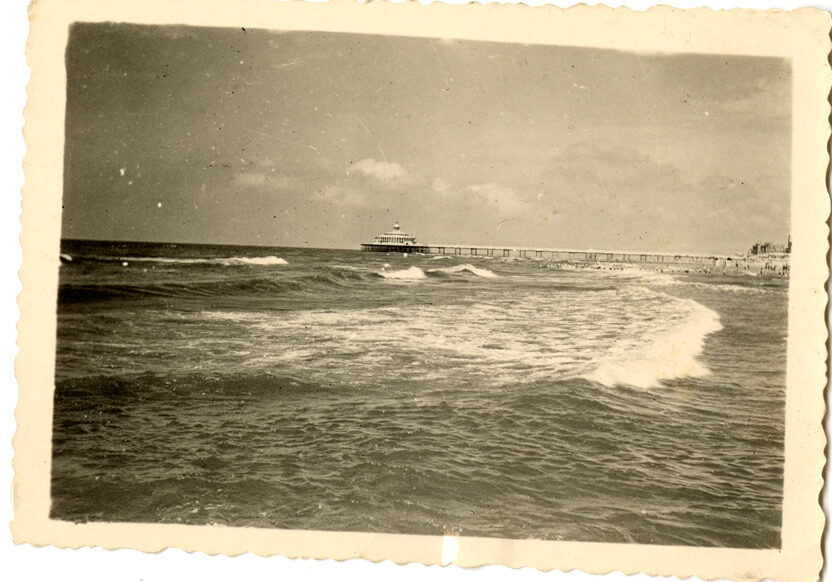

D: A beach with a dock and a building.
On the back:
There are five words written in pencil: “Von der dochil am Meer”
Written in pencil is “26” with a line through the “2”
Watermark for “Agfa-Lupex”2 See description for photograph B.
Printed number “4611”
“Von der dochil am Meer” is German for “of the dock at the sea.”
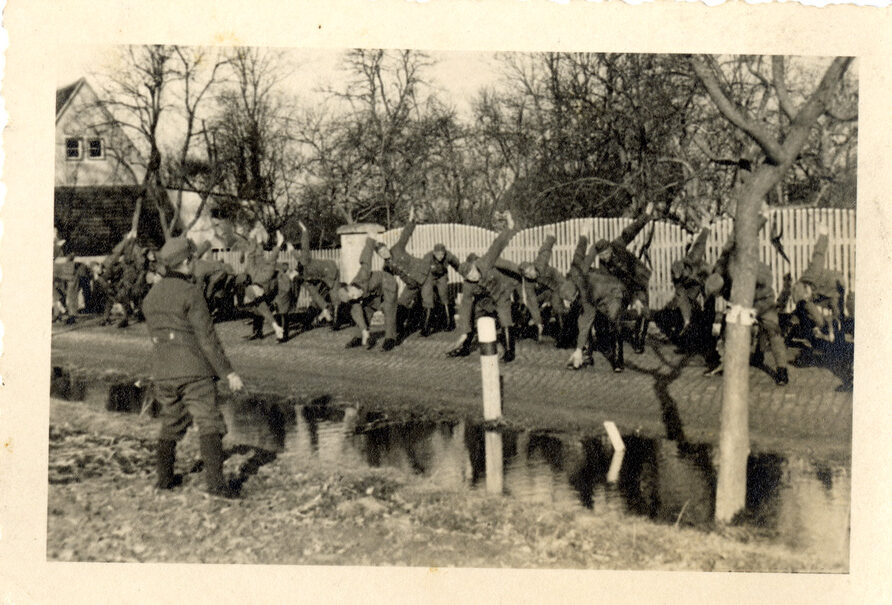
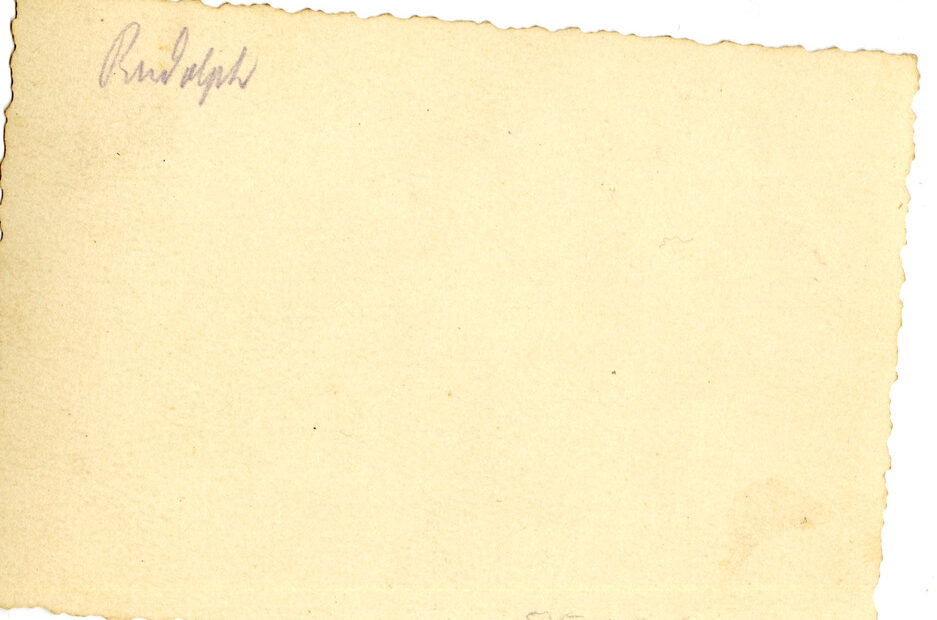
E: A group of German soldiers being instructed in physical exercises.
On the back:
Written in pencil: “Rudolph”
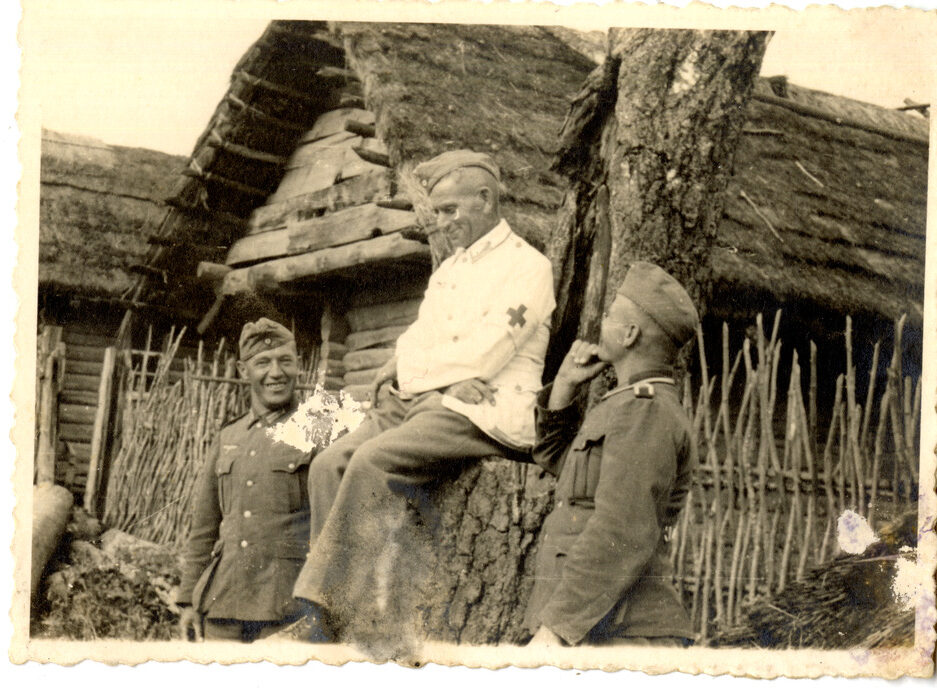
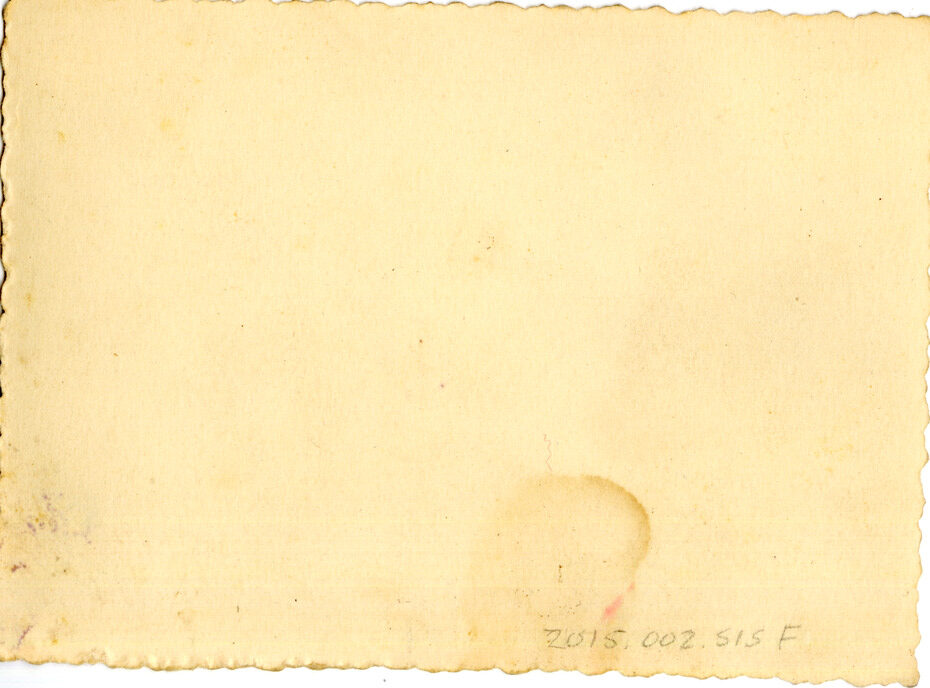
F: Three German soldiers smiling in front of a log building with a wicker fence in front of it. Soldiers on left and right are standing, and the soldier in the middle is sitting on a tree stump wearing a medic’s coat.
Nothing on the back
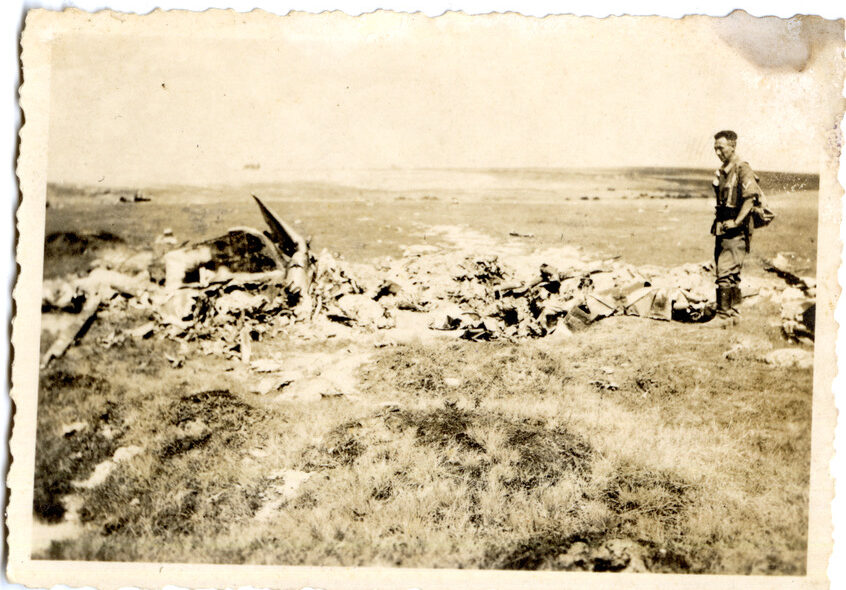

G: German soldier standing in a field looking at debris.
On the back:
Stamped in purple is “Foto E. Weber Nr. ………. Nachdruck verboten.”
On the dotted line in pencil is “230” and across the stamp written in pencil “230”
“Foto” is German for “photo.” After much research, the only mention of an “E. Weber” as a photographer was in a catalog record in the “Katalog der ausgestellten Fotografien.” Weber is named as the photographer of a picture in th catalog as being a part of the NSV Gaubildarchiv. The NSV was the National Socialist People’s Welfare, an organization within the Nazi party. “Gau” was an administrative subdivision of Nazi Germany, meaning states and provinces governed by Nazi party administration. “buildarchiv” is German for “photo archive.” If the E. Weber named in the catalog record was the photographer of the images in this collection with his stamp on the back, then it is likely he was a photographer working with the NSV organization. “Nachdruck verboten” is German for “reprinting prohibited.”
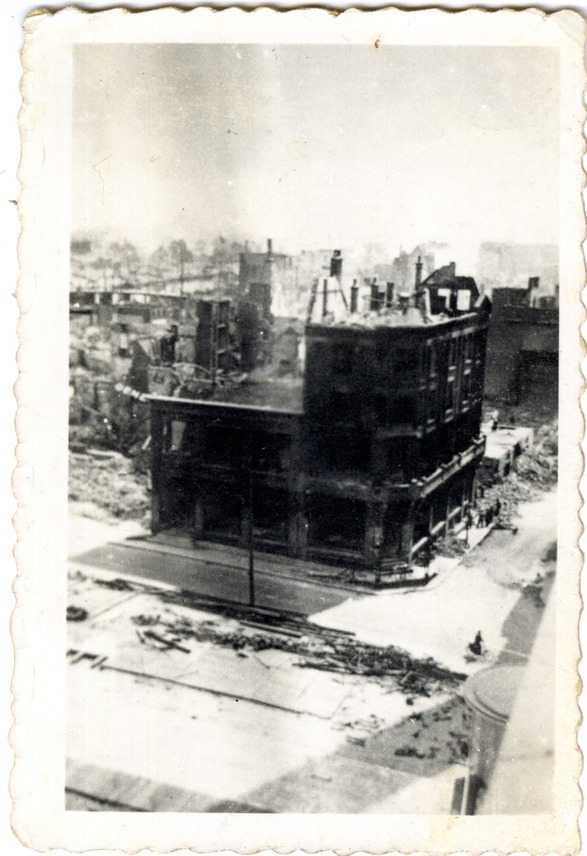

H: A burned out building in front of a destroyed city. Picture most likely taken from a window.
Nothing on the back


I: Three German soldiers posing with a tank. The tank hatch is open and a white “+” can be seen painted on the interior of the hatch door.
On the back:
Stamped in purple “Foto E. Weber Nr. ………. Nachdruck verboten.”3 See description for photograph G.
On the dotted line in pencil is written “231”
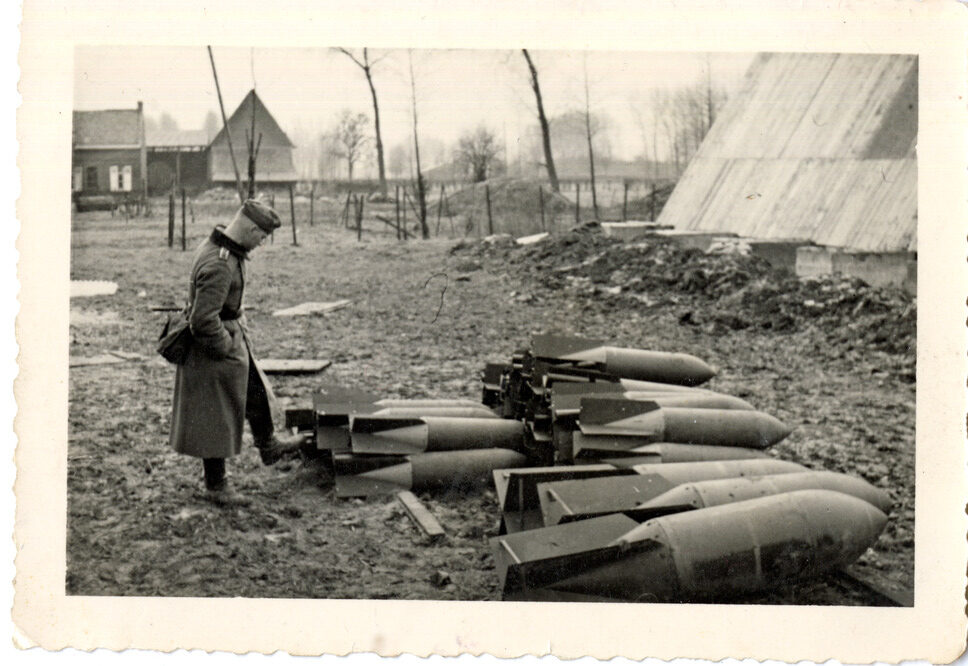
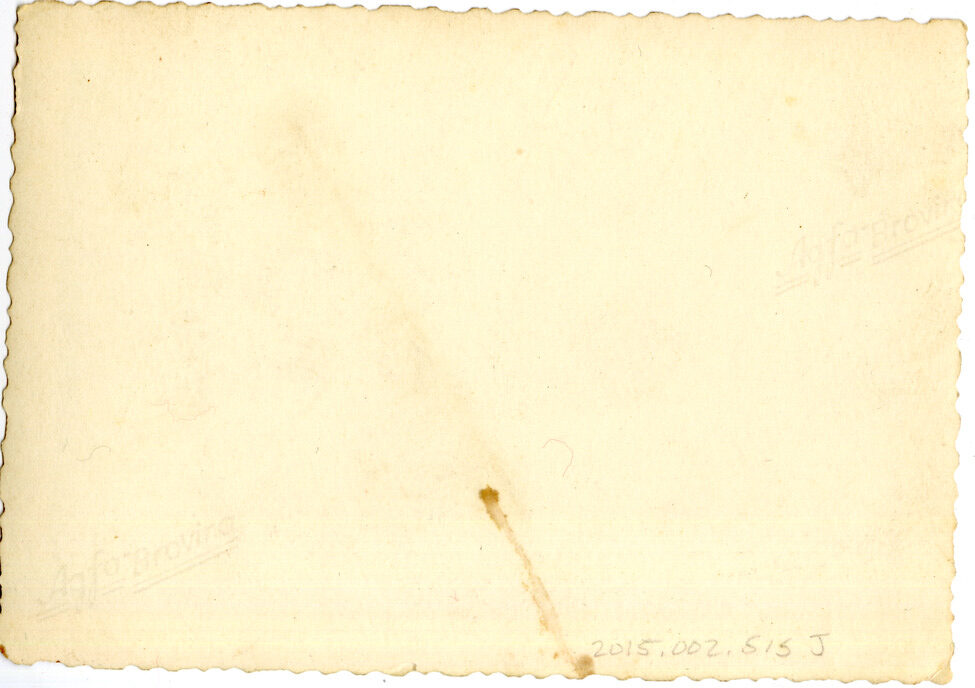
J: A German soldier standing in front of a pile of missiles.
On the back:
Watermark “Agfa-Brovira”4 See description of photograph A.
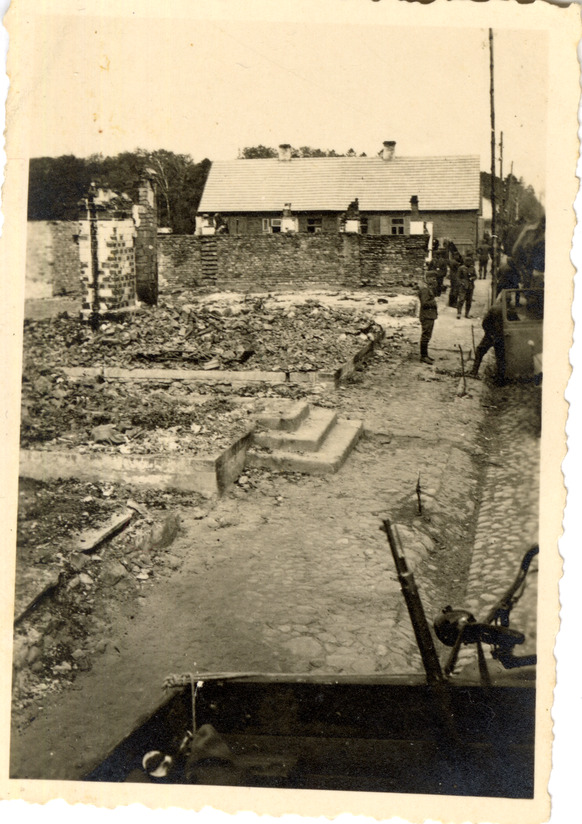
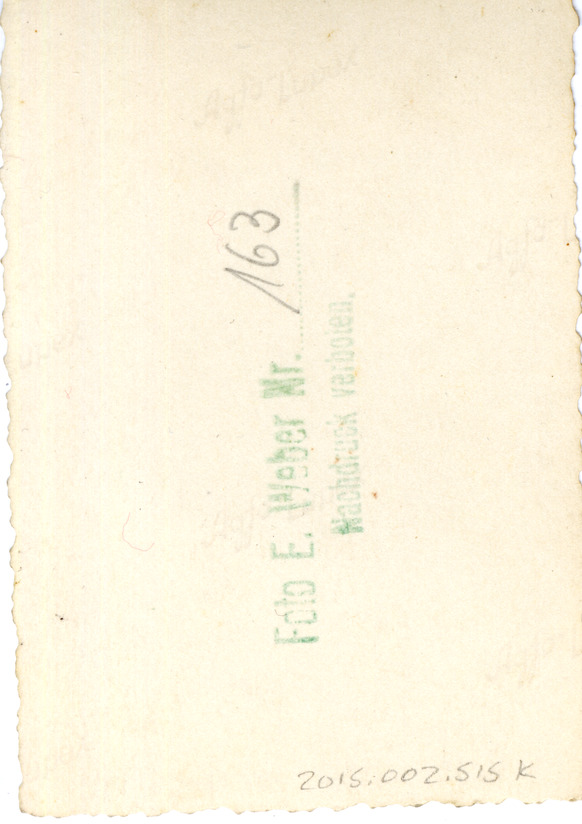
K: The ruins of a destroyed building with German soldiers are standing in front of it. There is what looks like part of a vehicle on the bottom right of the photograph, so the picture was most likely taken from the inside of a vehicle.
On the back:
Watermark “Agfa-Lupex”5 See description for photograph B.
Stamped in green “Foto E. Weber Nr. ………. Nachdruck verboten.”6 See description for photograph G.
On the dotted line in pencil is written “163”
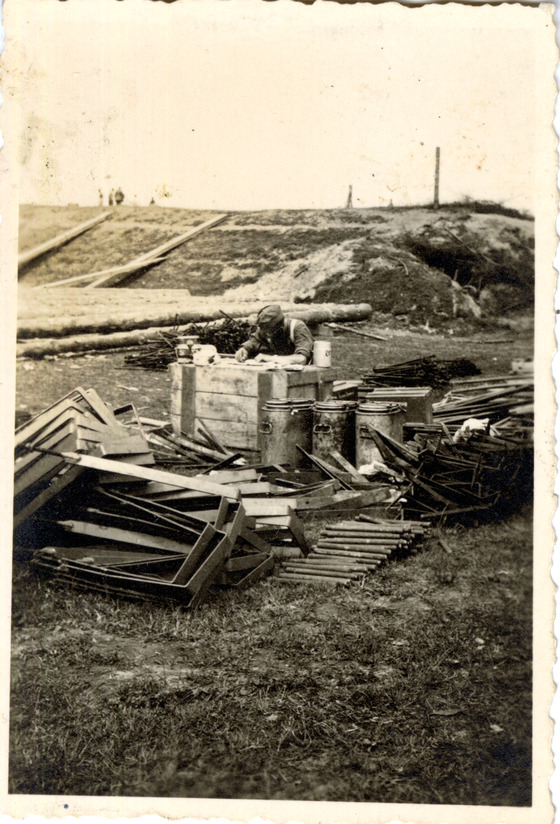
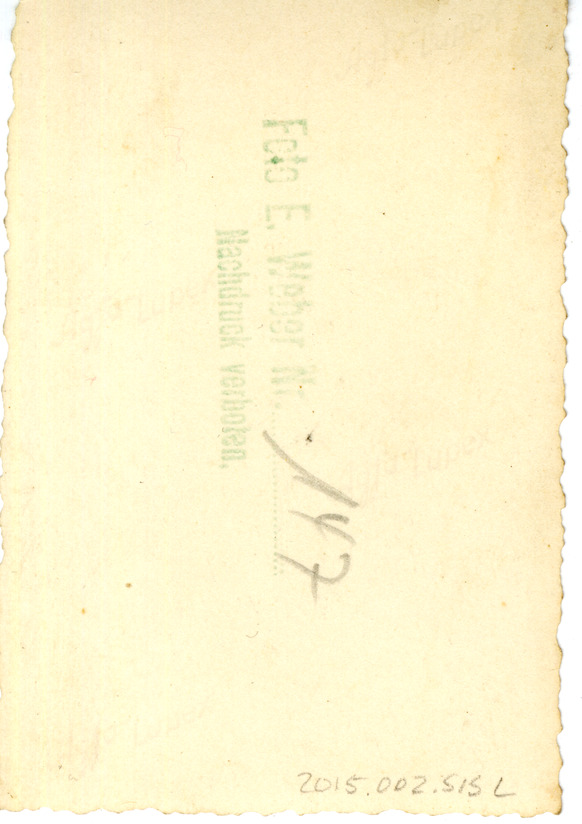
L: A German soldier sitting at a box being used as a small table in front of a hill. He appears to be writing something and is surrounded by various debris.
On the back:
Watermark “Agfa-Lupex”7 See description for photograph B.
Stamped in green “Foto E. Weber Nr. ………. Nachdruck verboten.”8 See description for photograph G.
On the dotted line in pencil is written “147”
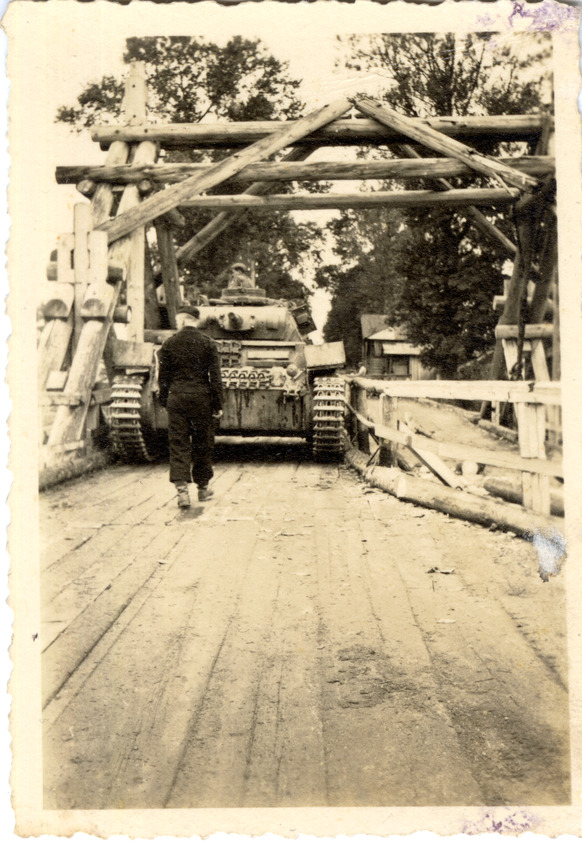
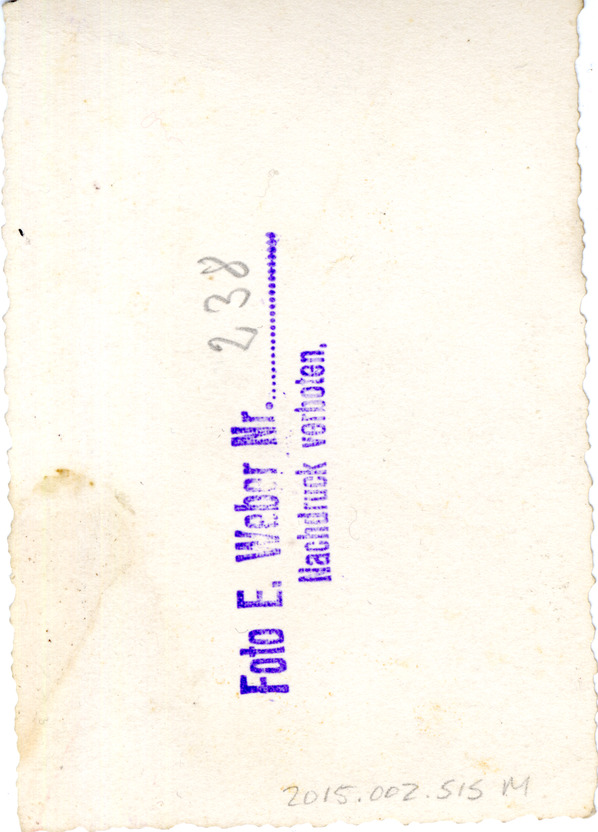
M: German soldier walking across a wooden bridge behind a tank.
On the back:
Stamped in purple “Foto E. Weber Nr. ………. Nachdruck verboten.”9 See description for photograph G.
On the dotted line in pencil is written “238”
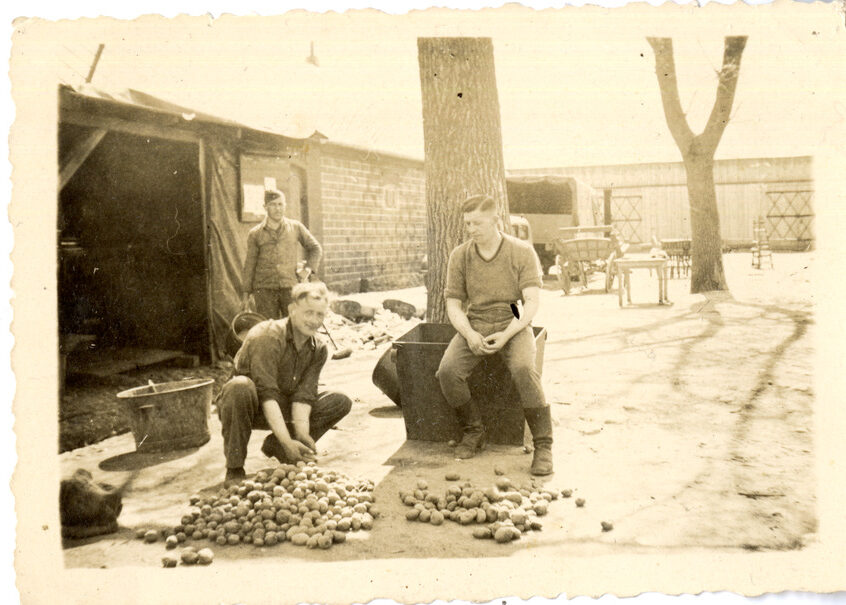
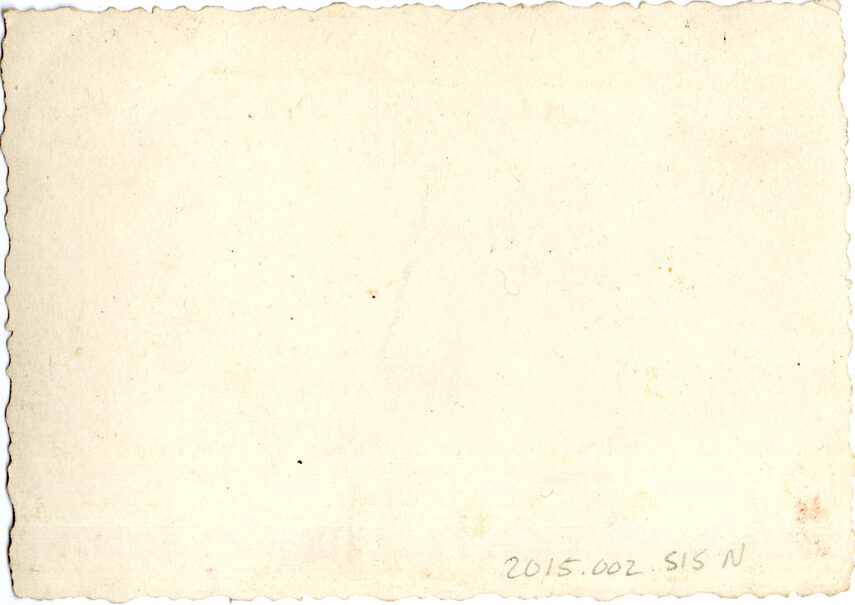
N: Three German soldiers in a courtyard. One soldier is in uniform and standing in the back by an open door. The one in the middle is squatting above a pile of potatoes and the other is on his right sitting on a bin in front of a tree.
Nothing on the back

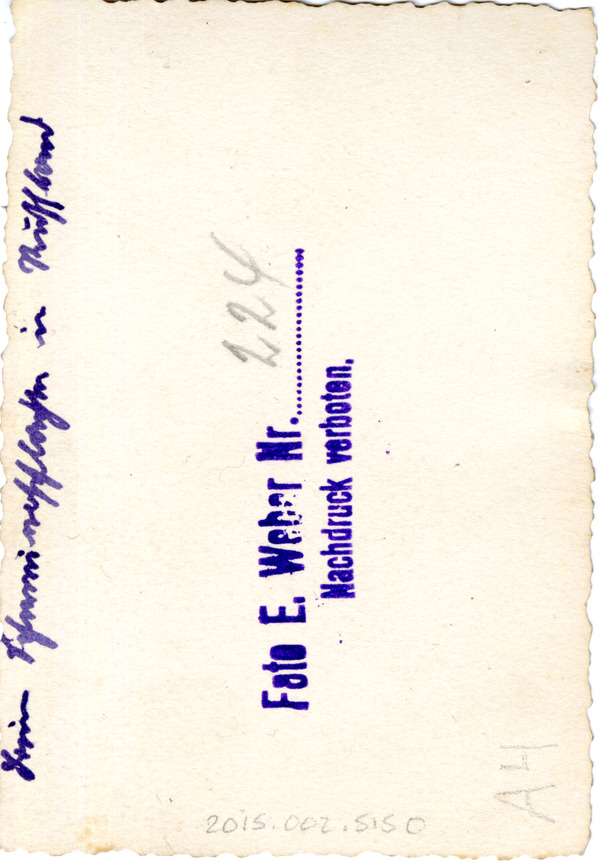
O: Eight German soldiers standing outside of a building butchering a pig.
On the back:
Written in purple ink are four words: “[unintelligible] Schwein [unintelligible] in Russland”
Below the written words is stamped in purple “Foto E. Weber Nr. Nachdruck verboten.”10 See description for photograph G.
On the dotted line in pencil is written “224”
Bottom left corner of the photograph written in pencil “A4”
The writing that says “[unintelligible] Schwein [unintelligible] in Russland” is German and translates to “[unintelligible] pig [unintelligible] in Russia.”
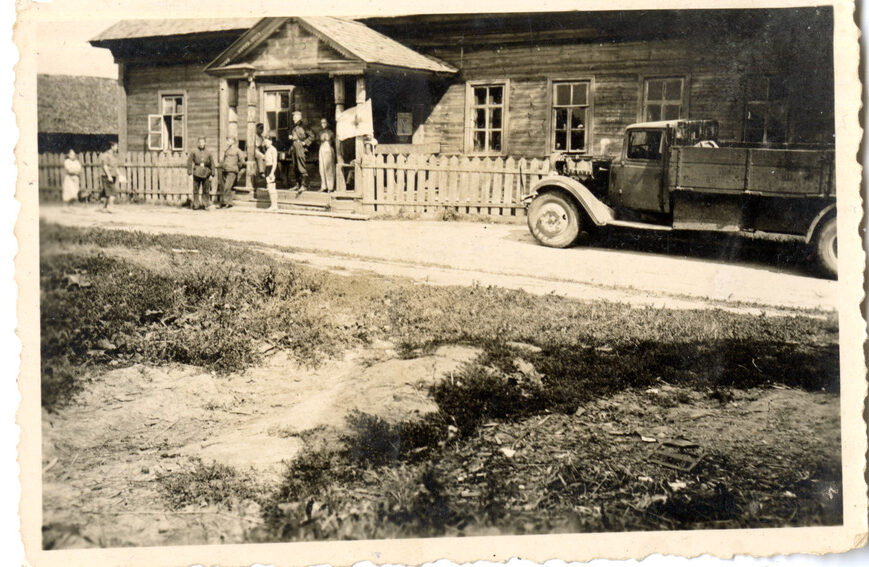
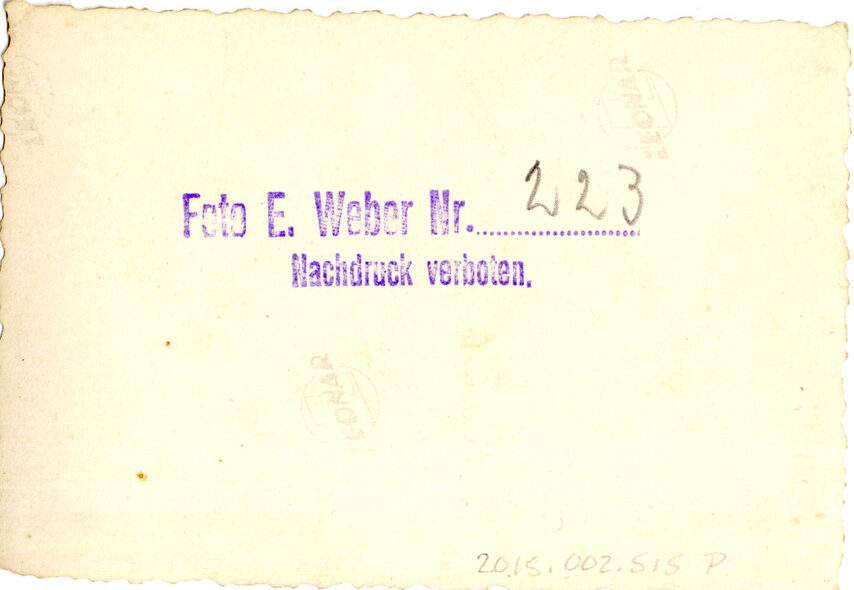
P: From far away, a small group of German soldiers and civilians standing around what is likely the entrance of a medical building with a cross on a flag near the entrance. There is also a truck outside of the building.
On the back:
Below the written words is stamped in purple “Foto E. Weber Nr. ………. Nachdruck verboten.”11 See description for photograph G.
On the dotted line in pencil is written “223”
Watermark “Leonar” printed in front of a circle with an “L” inside of it
The “Leonar” watermark indicates that this photograph was printed on Leonar photographic paper, which was a popular German photographic paper used in the 1930s and 1940s.
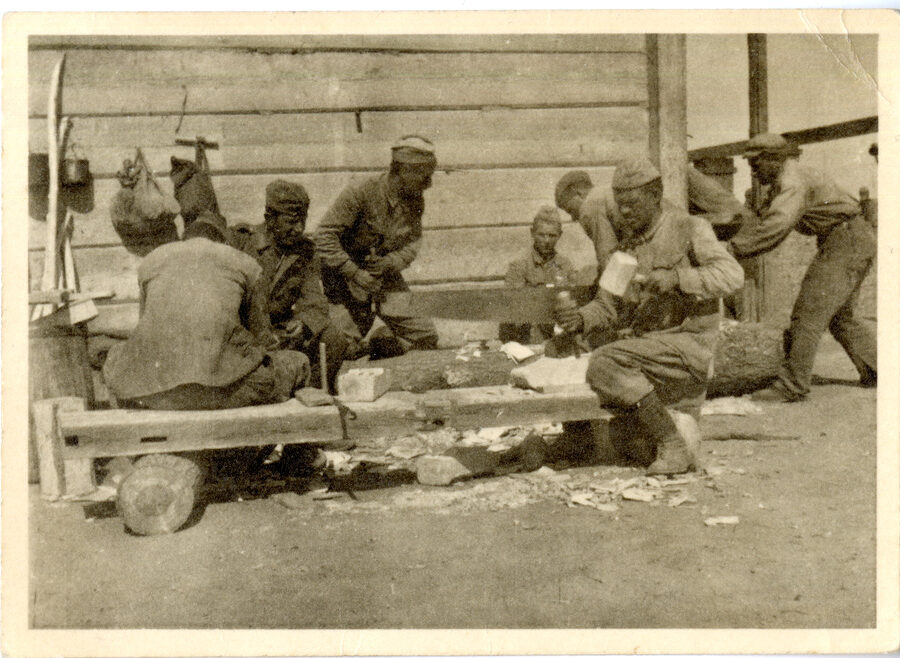

Q: Seven men in uniform working with wood outside of a building.
On the back:
In blue pencil is written: “1 x 30 x 42”
Under this set of numbers: “1 x 385 x 55”
There is a line in blue pencil under this set of numbers
Below the line is a word written in blue pencil: “ßiulnd”
The word in blue pencil is written over the number “90” which was written in pencil
Note: This photograph is on a different paper than the majority of the other photographs in this group. It is a thicker paper with no scalloped edges.
The word “ßiulnd” is German for “guilty.” It is possible that because the soldiers in this photograph are doing woodworking, the numbers written on the back may have something to do with what they are building, perhaps the dimensions. It is likely that these men were POWs.
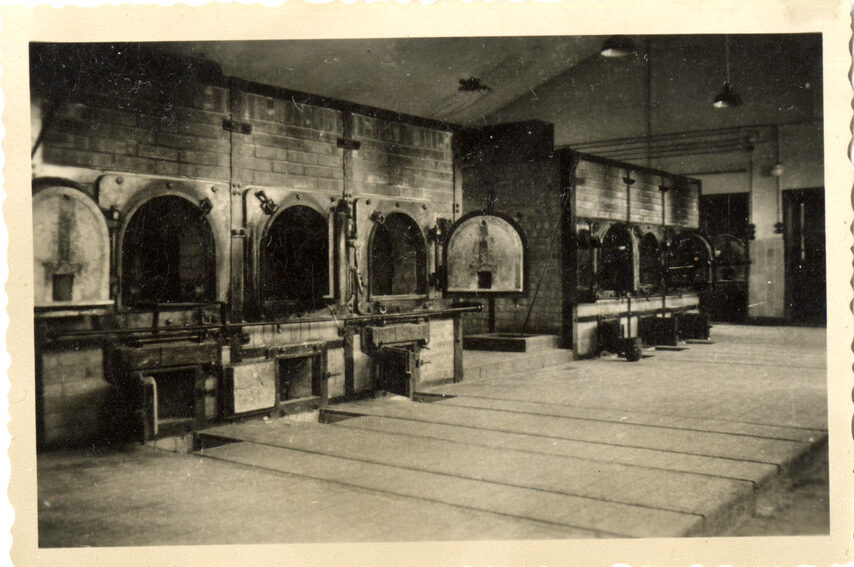
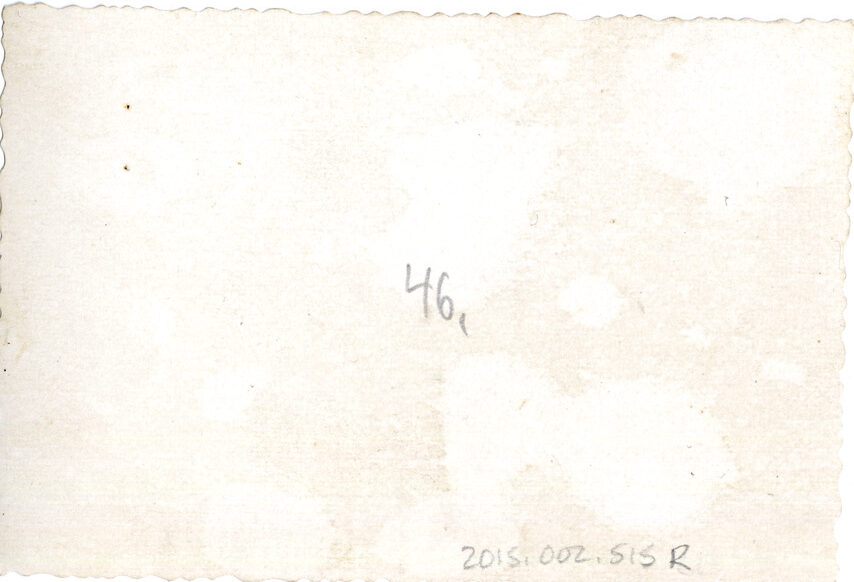
R: The interior of a crematorium, likely in a concentration camp.
On the back:
Written in pencil “46.”

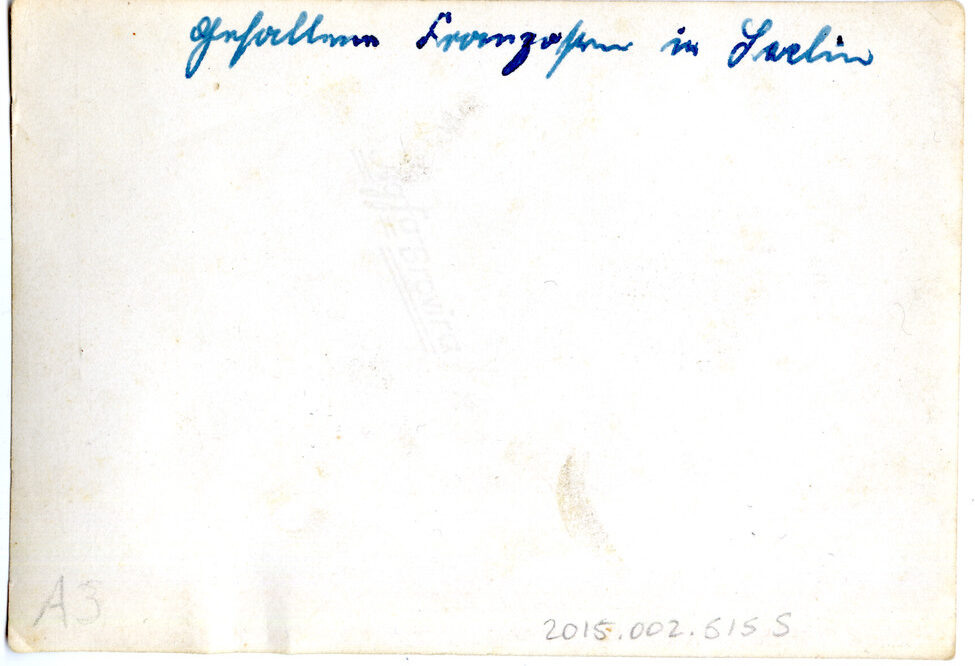
S: Three soldiers standing beside a grave for French soldiers. In the grave are five wooden crosses with helmets placed on top of them.
On the back:
Written in blue ink is “Gefallen Franzosen in [unintelligible]”
Bottom left corner written in pencil “A3”
Watermark “Agfa-Brovira”12 See description of photograph A.
Note: This photograph has the same paperweight as the majority of the photographs but has no scalloped edges.
“Gefallen Franzosen in [unintelligible]” is German for “Fallen Frenchmen in [unintelligible].”

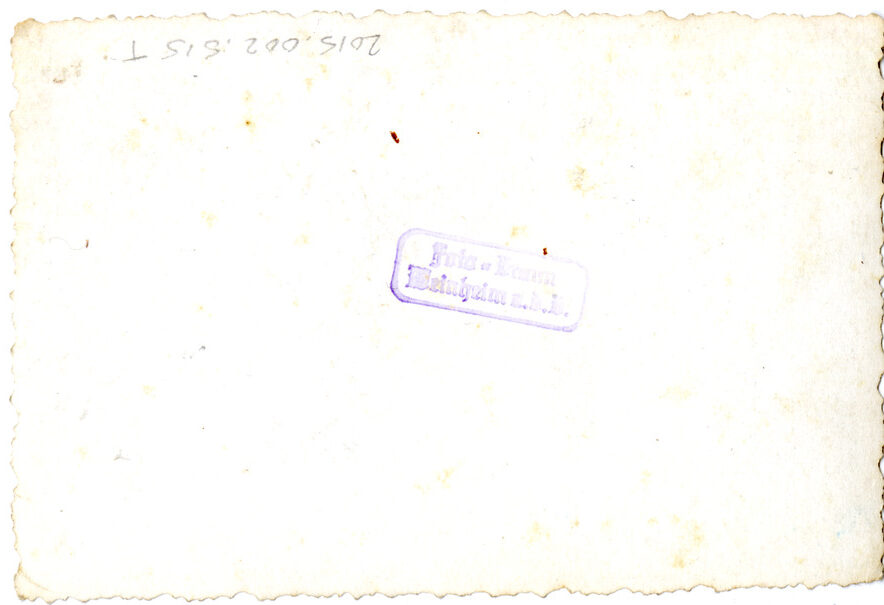
T: An open grave containing a row of what appear to be the bodies of nine soldiers, with their top halves covered by cloth.
On the back:
A rectangular stamp in purple ink: “Foto-Breim Weinheim a.b.B”
Weinheim is a town in southwestern Germany. “Foto” is German for “photo.” The exact origin of this watermark is unclear.

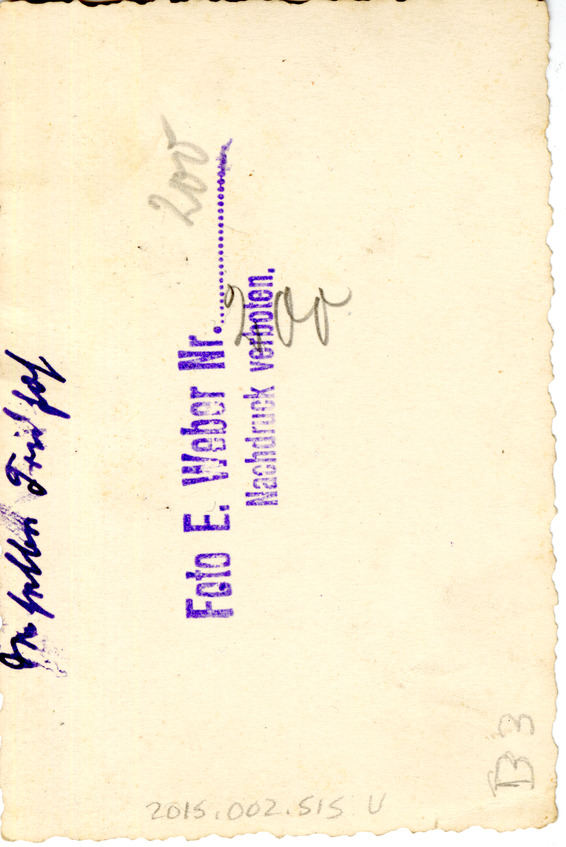
U: An open grave containing ten bodies wrapped in shrouds; some of the shrouds appear to be made of camouflage fabric. There is also a wooden coffin in the grave with them. German soldiers are standing behind the grave.
On the back:
In purple ink are three words: “In selbe Grabhof”
Below the written words is stamped in purple “Foto E. Weber Nr. ………. Nachdruck verboten.”13 See description for photograph G.
On the dotted line in pencil is written “200”
“200” is also written in pencil across the bottom of the stamp
Bottom left corner written in pencil “B3”
“In selbe Grabhof” is German for “in the same graveyard.”
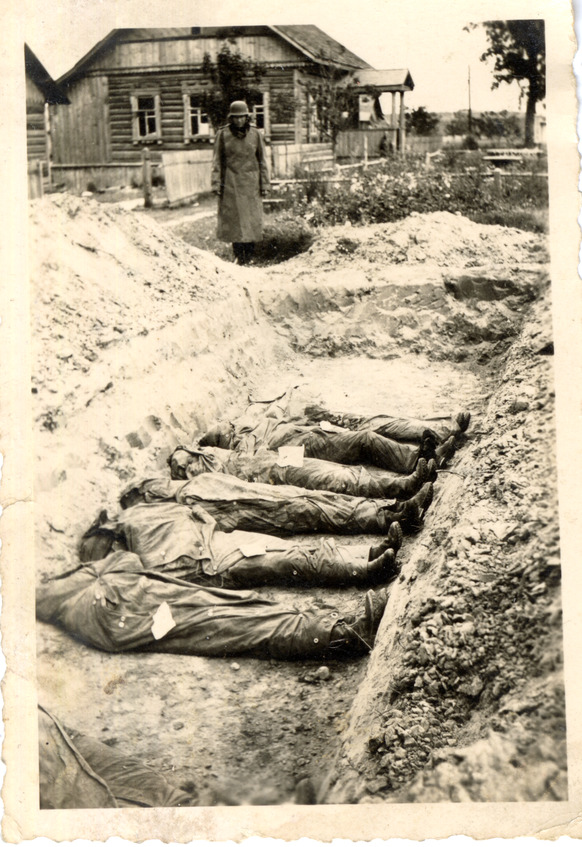
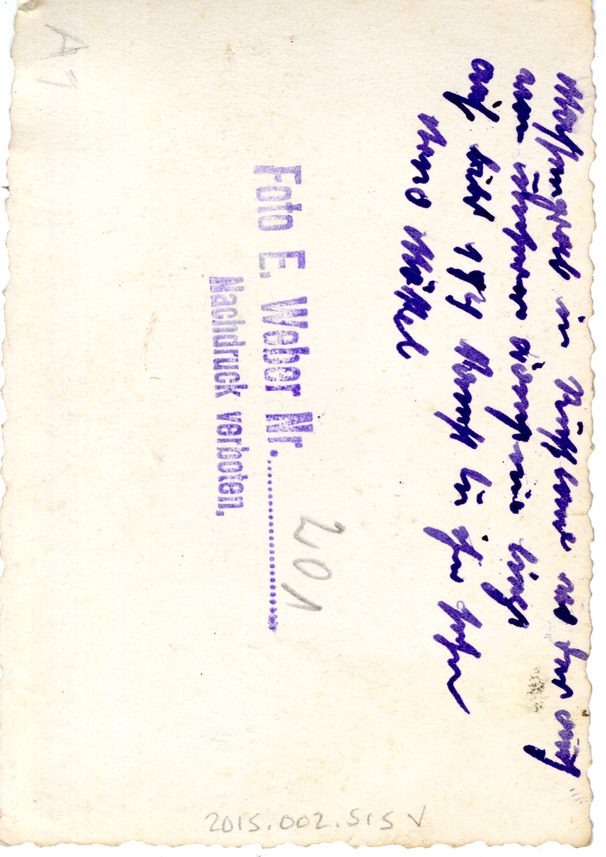
V: An open grave containing six bodies wrapped in shrouds. A German soldier is standing above the grave.
On the back:
Written in purple ink: “Massengrab in Russland [unintelligible] der auf [unintelligible] [unintelligible] kompanie [unintelligible] auf [unintelligible] 184 [unintelligible] ihn sehn [unintelligible] [unintelligible]”
Below the written words is stamped in purple “Foto E. Weber Nr. ……….. Nachdruck verboten.”14 See description for photograph G.
On the dotted line in pencil is written “201”
Bottom left corner written in pencil “A1”
“Massengrab in Russland [unintelligible] der auf [unintelligible] [unintelligible] kompanie [unintelligible] auf [unintelligible] 184 [unintelligible] ihn sehn [unintelligible] [unintelligible]” is German for “Mass grave in Russia [unintelligible] up the [unintelligible] [unintelligible] company [unintelligible] on [unintelligible] 184 [unintelligible] he sees [unintelligible] [unintelligible].”
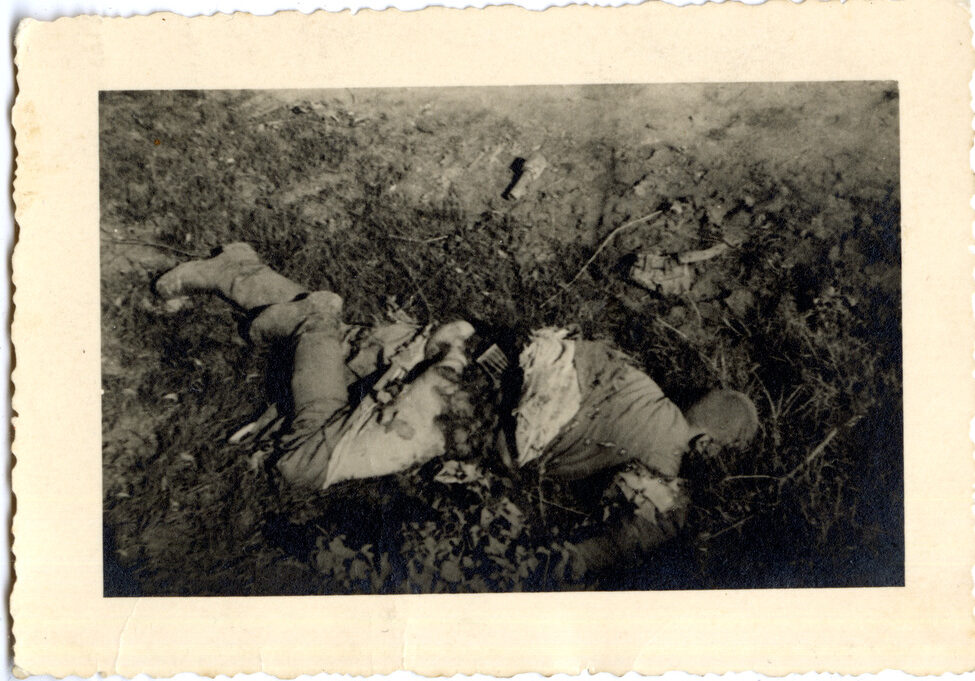
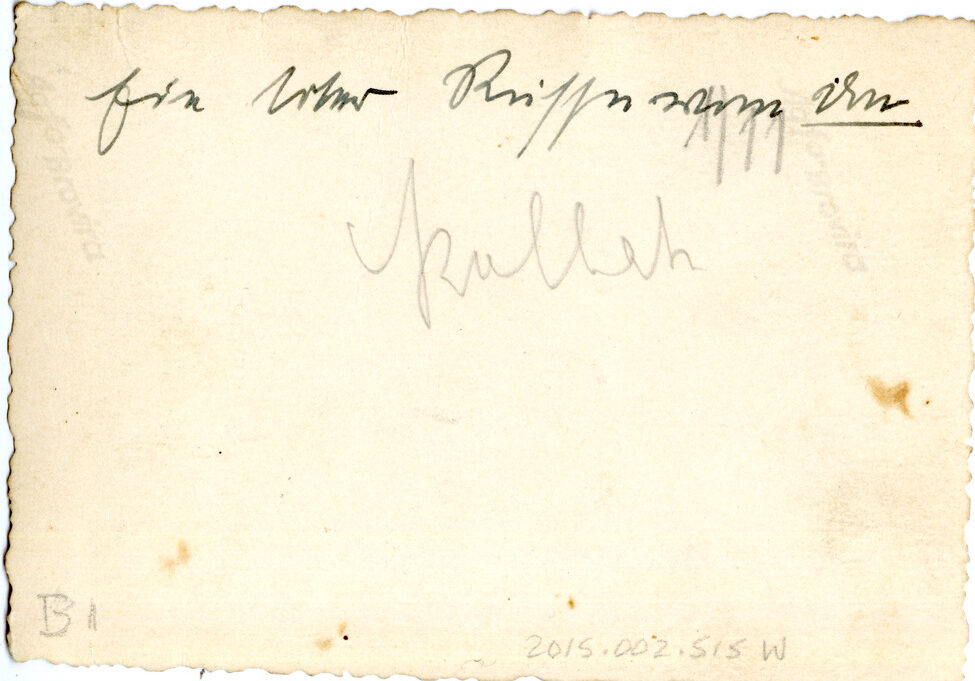
W: A dead soldier. It is unclear if the soldier is German.
On the back:
Five words written in black ink, with the last word underlined: “Ein [unintelligible] Russn [unintelligible] [unintelligible]”
Written below in pencil is “kulleh” and “1/11”
Bottom left corner in pencil “B1”
Watermark “Agfa-Brovira”15 See description of photograph A.
Note: The photograph has scalloped edges, but the paper is much heavier than the other photographs.
“Ein [unintelligible] Russn [unintelligible] [unintelligible]” is German for “A [unintelligible] Russian [unintelligible] [unintelligible].” “kulleh” is German for “cool.”
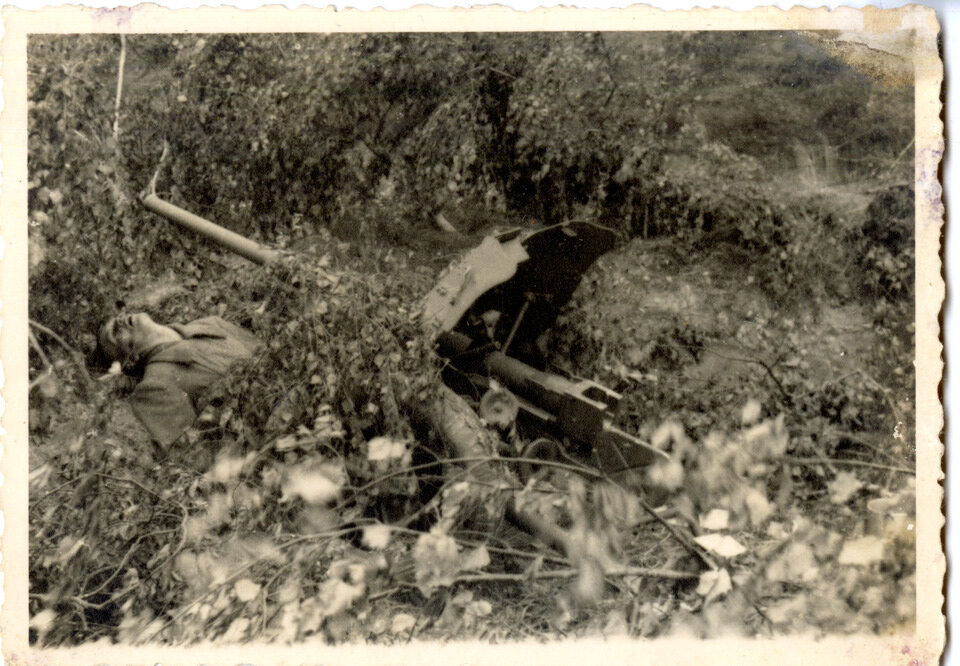
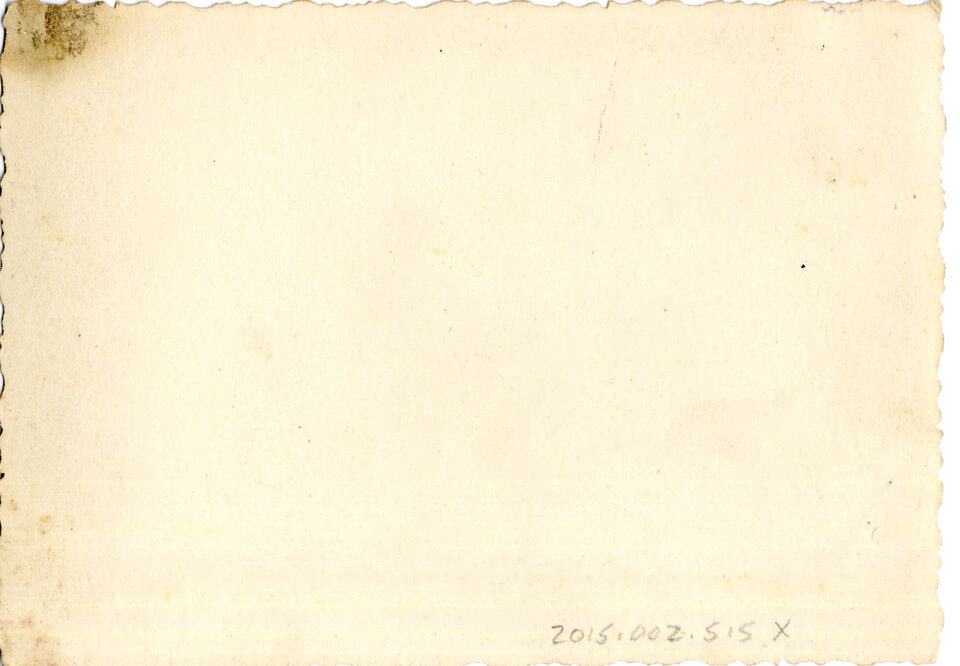
X: A dead soldier in a field next to a damaged piece of artillery.
Nothing on the back
Note: The photograph has scalloped edges, but the paper is much heavier than the other photographs.
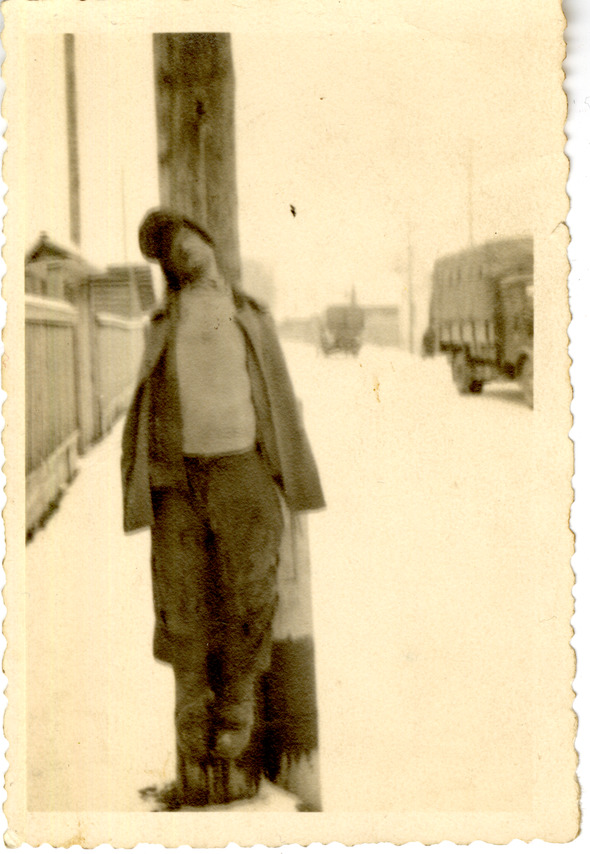
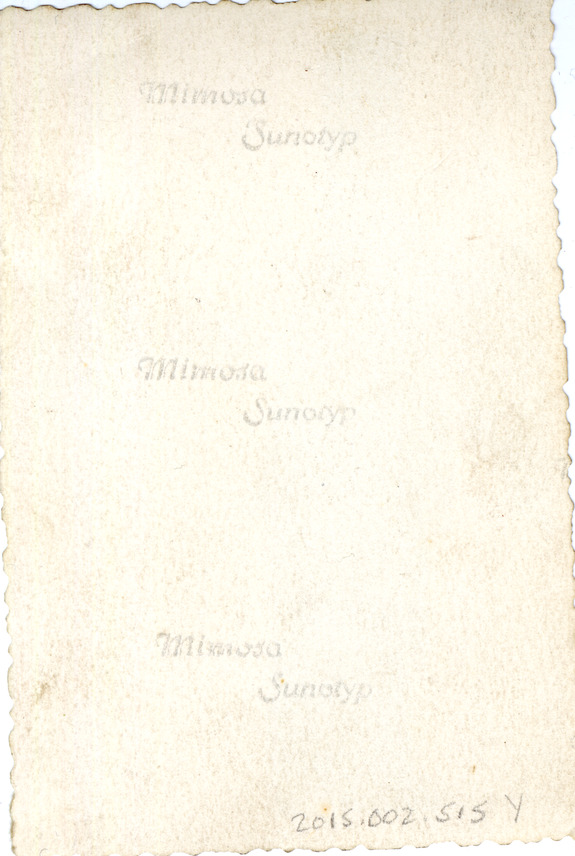
Y: A blurry photograph of a soldier hanging from a wooden pole on a noose. There are two military trucks in the background.
On the back:
Watermark “Mimosa Sunotyp”
Mimosa was a German photographic paper company that operated during World War II, and Sunotyp was a type of paper that they produced.


Z: A group of 21 German soldiers sitting around a campfire in the woods with a makeshift tent in the background.
Nothing on the back.
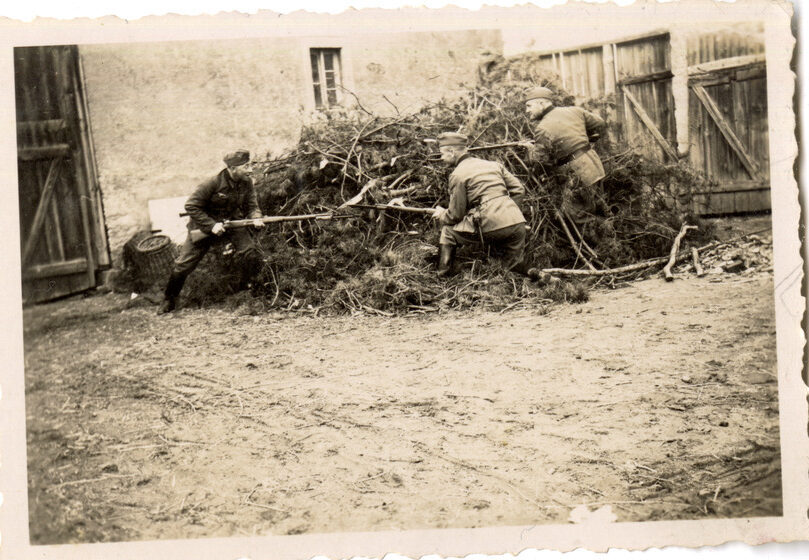

AA: Three German soldiers outside of a building pointing bayonets at each other in front of a pile of branches. It appears that the soldiers are pointing the weapons at each other jokingly.
On the back:
Watermark “Leonar” printed in front of a circle with an “L” inside of it16 See description for photograph P.
Written in pencil “1”
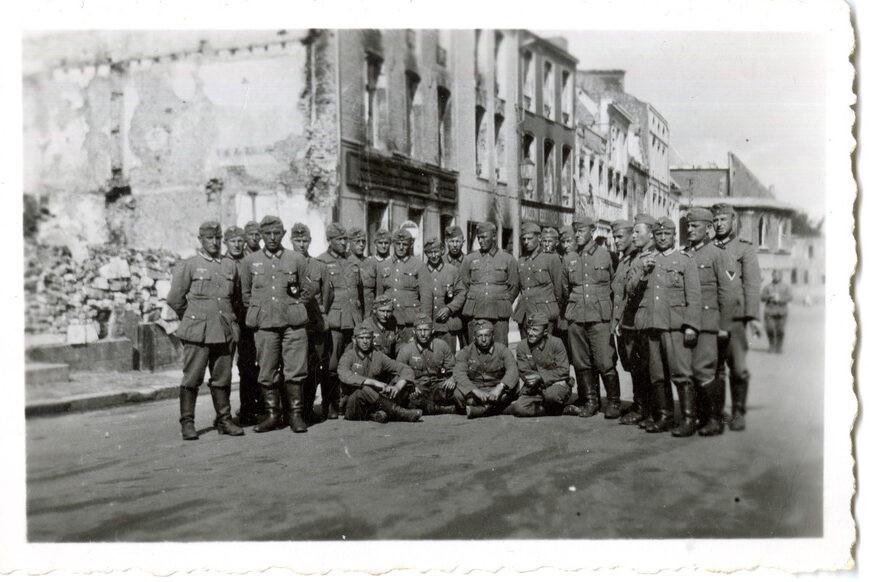

BB: A large group of German soldiers posed together in the middle of a road next to a destroyed building. There are 5 soldiers sitting in the front and 21 standing behind them. There is another soldier walking in the background.
Nothing on the back

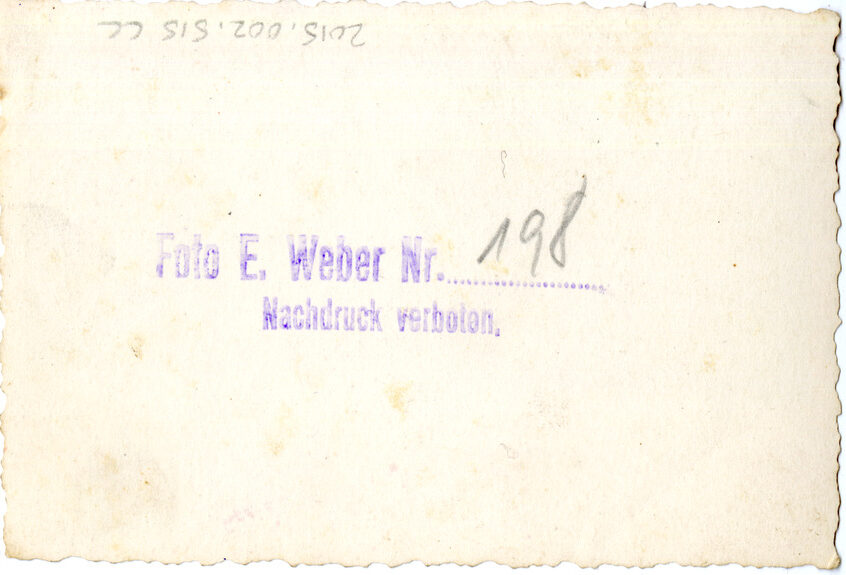
CC: A group of German soldiers standing at attention shown from the back. The soldiers are facing a small cemetery in the background.
On the back:
Stamped in purple “Foto E. Weber Nr. ………. Nachdruck verboten.”17 See description for photograph G.
On the dotted line in pencil is written “198”
Note: A portion of a sign in the photograph next to the graves can be partially read. Part of the sign includes the word “Friedhof” which is German for graveyard.
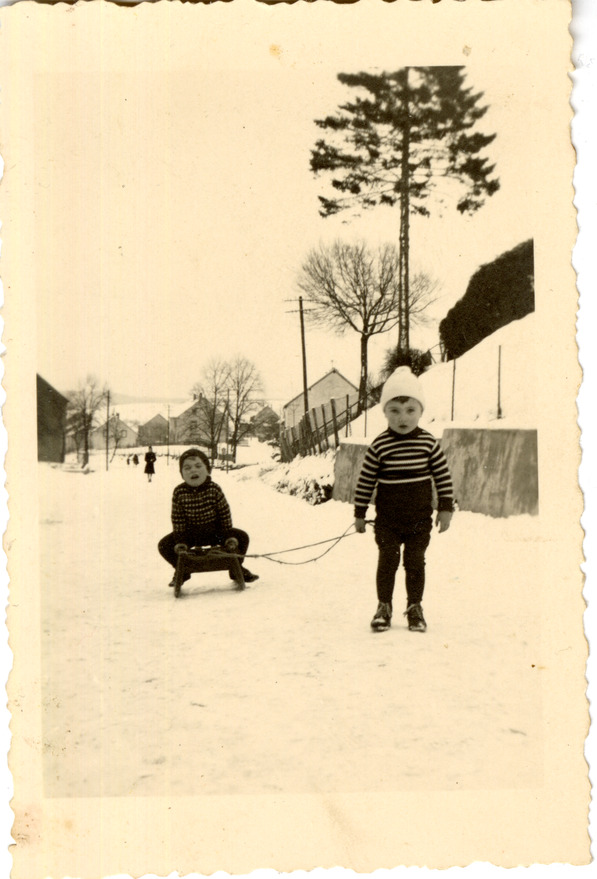
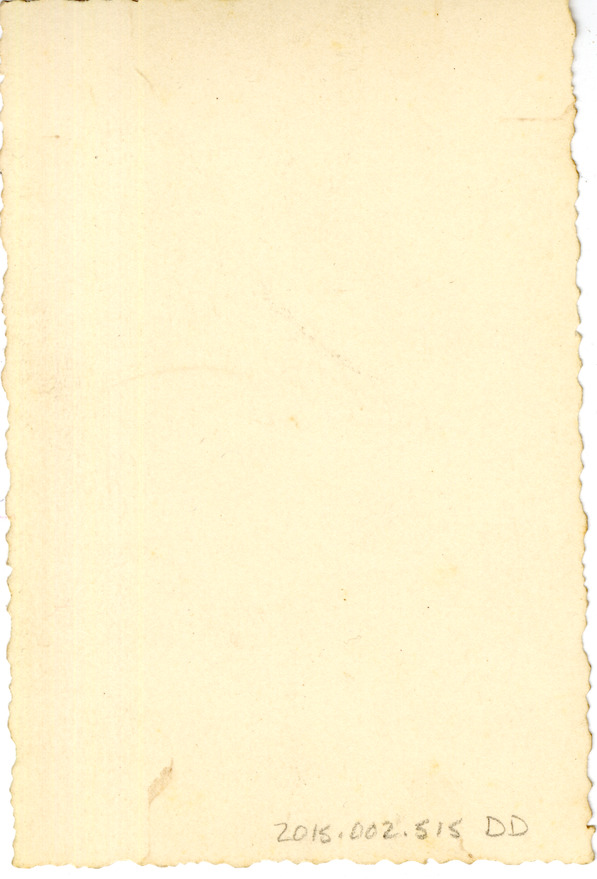
DD: Two young boys in the snow. One child is pulling the other who is sitting on a sled.
Nothing on the back
Note: The photograph has scalloped edges but the paper is much thicker than the majority of the photographs.
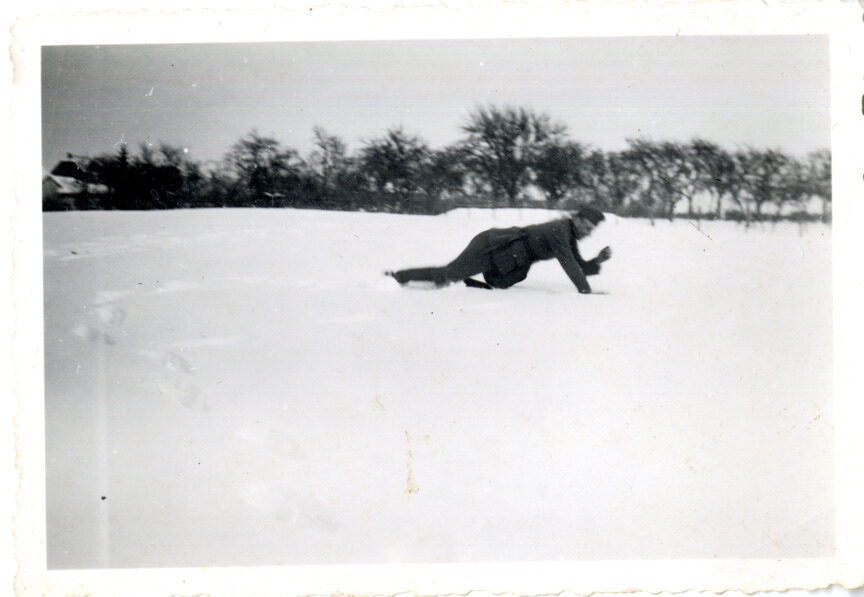

EE: A German soldier crawling in a snowy field. It does not appear to be taken during combat as he is the only person in the photograph and there are houses in the background.
On the back:
Watermark “Agfa-Lupex”18 See description for photograph B.
Written in pencil is “10”

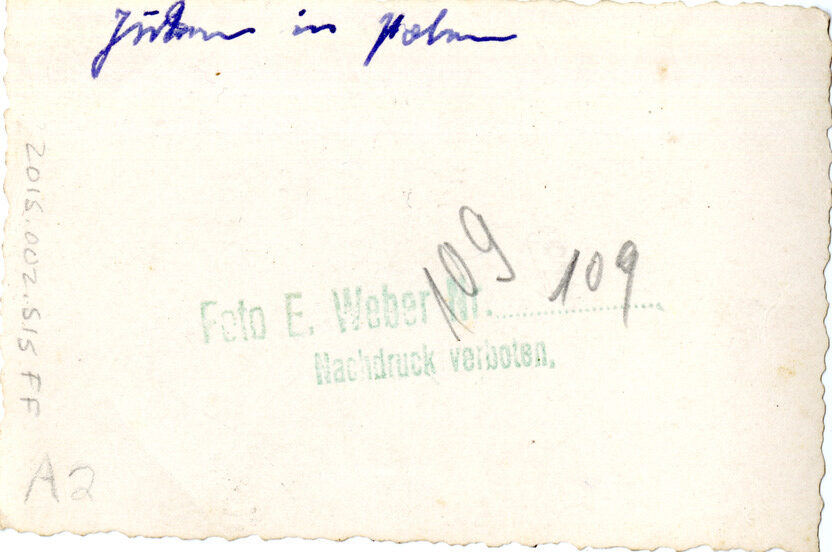
FF: Two Jewish men standing outside of a building. They are both wearing armbands, likely to identify them as Jews.
On the back:
Written in blue ink is “Jüdin in Polen”
Stamped in green “Foto E. Weber Nr. ………. Nachdruck verboten.”19 See description for photograph G.
Over the stamp and on the dotted line in pencil is written “109” twice
In the bottom left corner written in pencil is “A2”
“Jüdin in Polen” is German for “Jews in Poland.”
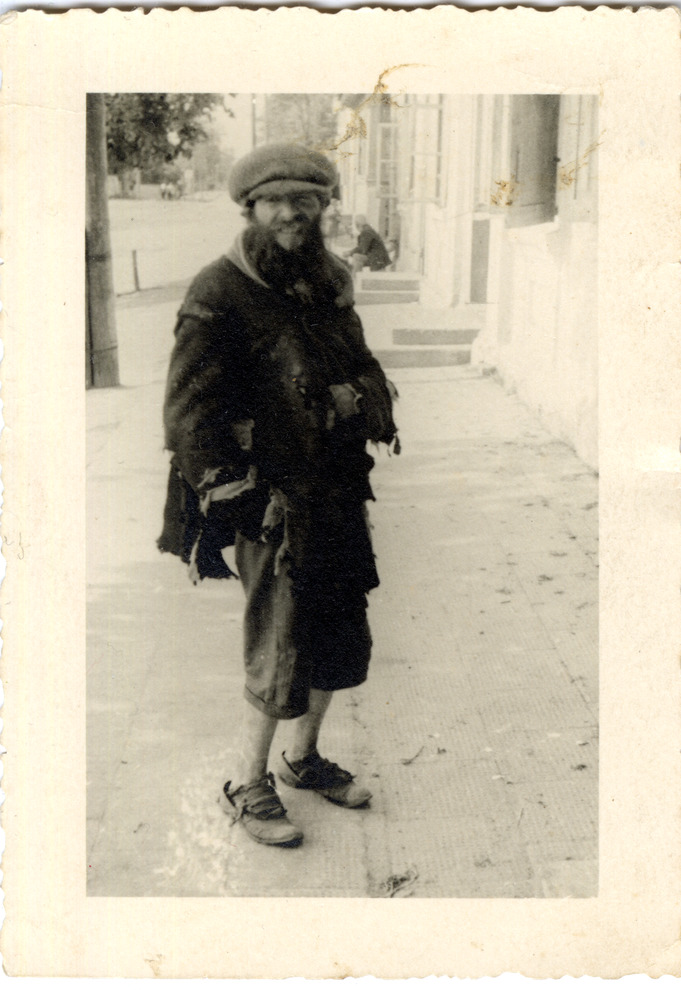
![Four words written in black pen, with the fourth word underlined: “Ein Jude wem [unintelligible]”. Next to the words in pencil is “2/7”. One word written in pencil in the middle “[?]ulleh”. Bottom left corner is written in pencil “B2”.](https://humanitieslab.goucher.edu/lest-i-forget/wp-content/uploads/sites/19/2023/04/Goetz-Appendix-II-Image-GG2-e1682013714211.jpg)
GG: A man wearing torn clothing standing alone on a sidewalk.
On the back:
Four words written in black pen, with the fourth word underlined: “Ein Jude wem [unintelligible]”
Next to the words in pencil is “2/7”
One word written in pencil in the middle “[?]ulleh”
Bottom left corner is written in pencil “B2”
Note: The photograph has scalloped edges but the paper is much thicker than the majority of the photographs.
“Ein Jude wem [unintelligible]” is German for “A Jew who [unintelligible].” It is unclear what the first letter of the word “[?]ulleh” is. Another photograph in this collection had “kulleh” written on the back, which is German for “cool;” it is possible that this is what was meant to be written on the back of this photograph as well.

![Watermark: “Agfa-Brovira” Written in pencil: “867” A word is written in pencil “[?]ulleh” In blue pen is written “5/3”](https://humanitieslab.goucher.edu/lest-i-forget/wp-content/uploads/sites/19/2023/04/Goetz-Appendix-II-Image-HH2-e1682014008338.jpg)
HH: A field with indistinguishable figures on the ground. The figures could possibly be dead soldiers.
On the back:
Watermark “Agfa-Brovira”20 See description of photograph A.
Written in pencil “867”
A word is written in pencil “[?]ulleh”21 See description for photograph GG.
In blue pen is written “5/3”
Note: The photograph has scalloped edges but the paper is much thicker than the majority of the photographs.
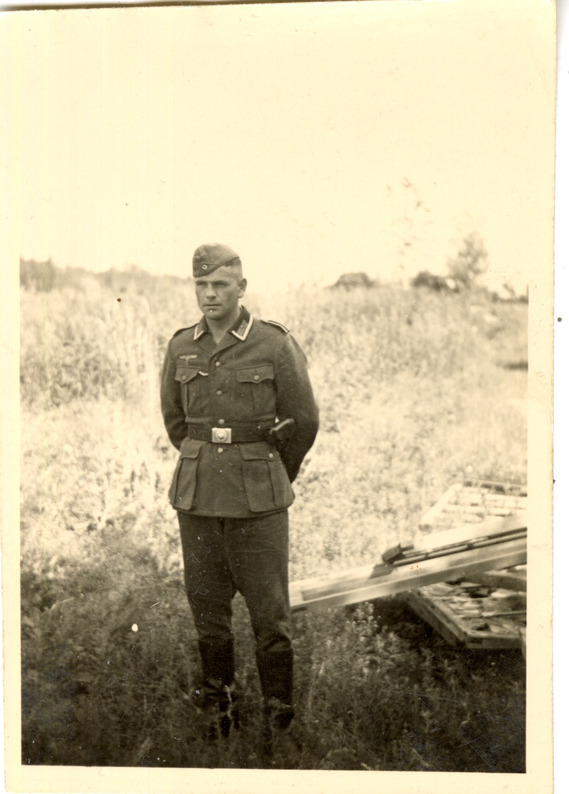
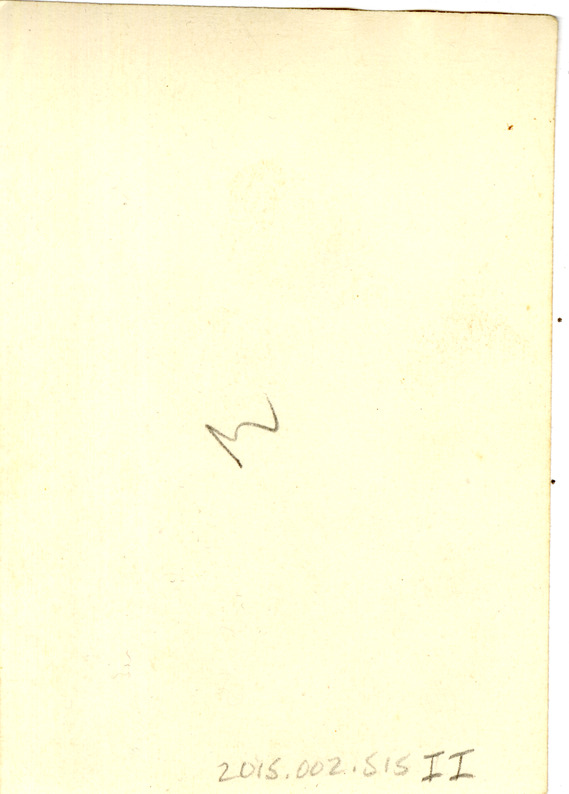
II: A German soldier standing at ease in a field. There is some debris in the background.
On the back:
There is a “3” written in pencil
Note: The photograph has no scalloped edges.
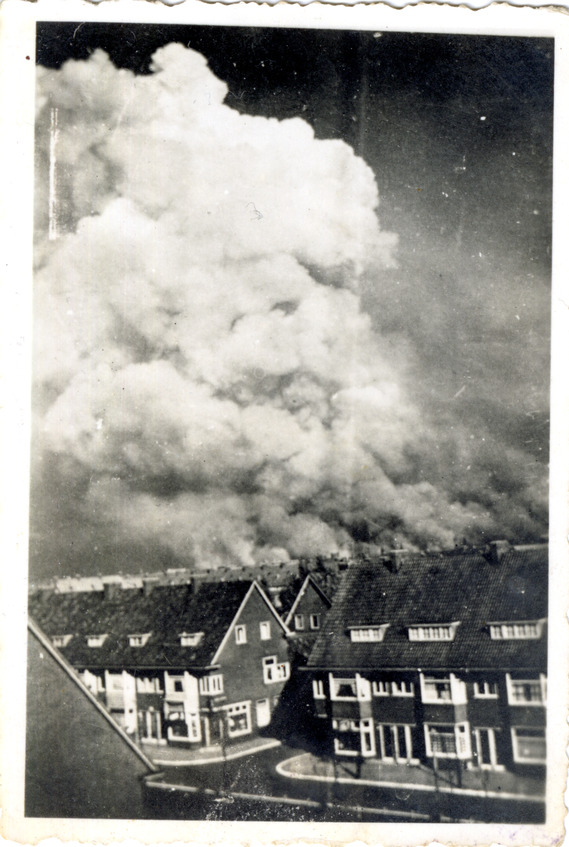

JJ: A town from the perspective of a roof of a building. It appears to be a residential area with row houses across the street. Behind the buildings is a large smoke cloud that is most likely the result of an explosion.
Nothing on the back
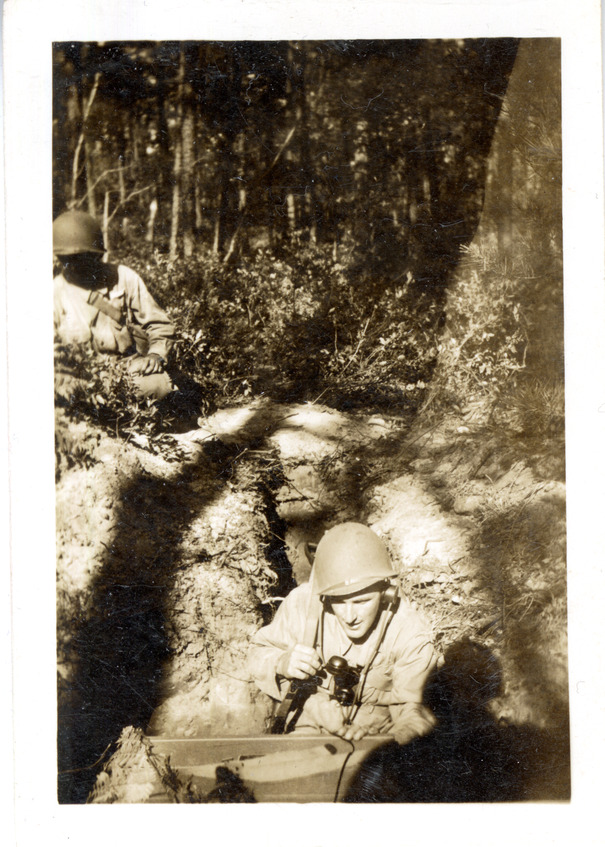
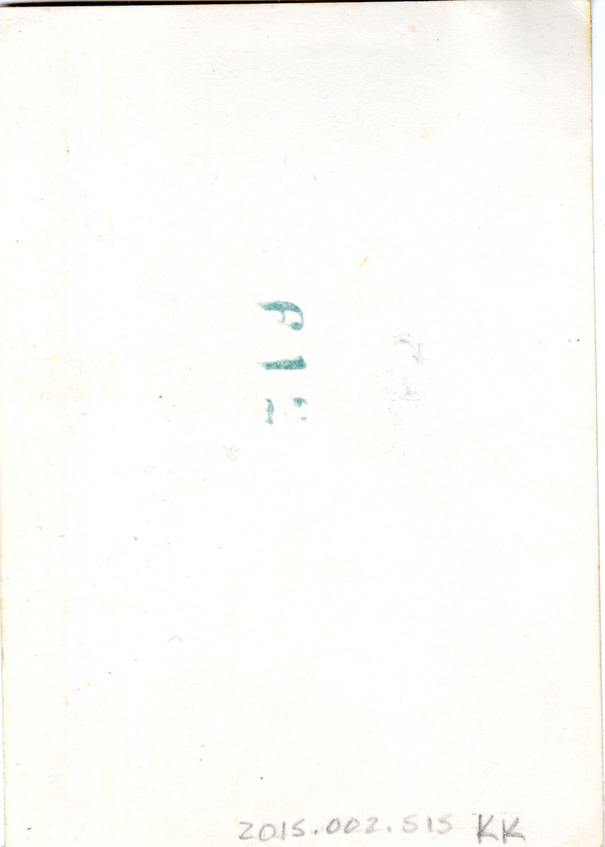
KK: Two soldiers in a forest. One soldier is kneeling on the ground while the other is crouched in a small ditch wearing headphones and speaking into a radio piece.
On the back:
A partial green stamp of the number “612”
Note: The photograph has no scalloped edges.
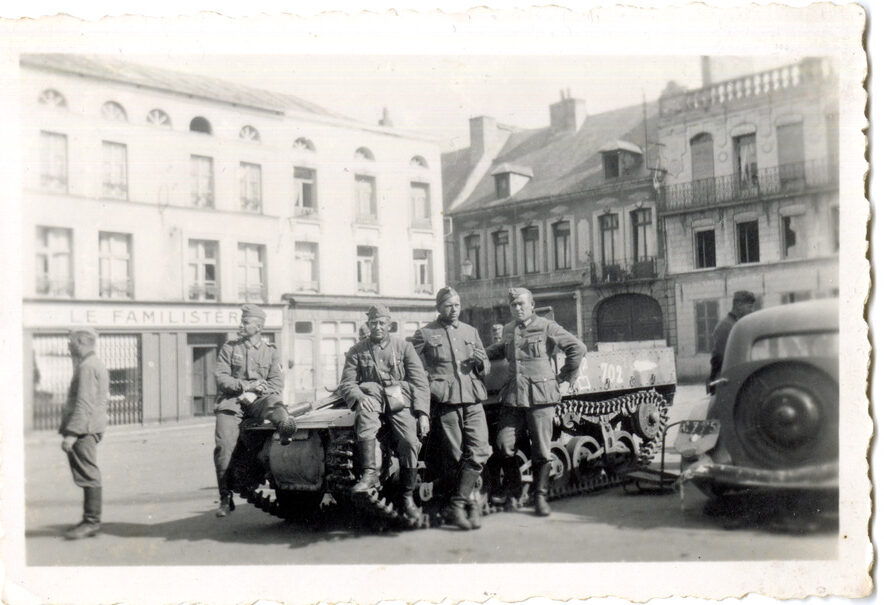
![Three words written in pencil: “ein Französischen [unintelligible]”.](https://humanitieslab.goucher.edu/lest-i-forget/wp-content/uploads/sites/19/2023/04/Goetz-Appendix-II-Image-LL2-e1682014581800.jpg)
LL: A group of soldiers posed in front of a tank in the center of a town. There is a building behind them with name “Le Familister”
On the back:
Three words written in pencil: “ein Französischen [unintelligible]”
“ein Französischen [unintelligible]” is German for “a French [unintelligible].” “Le Familistere” may refer to a form of cooperative housing that was modeled after Jean-Baptiste Godin’s factory worker housing complex and community, Le Familistère de Guise.